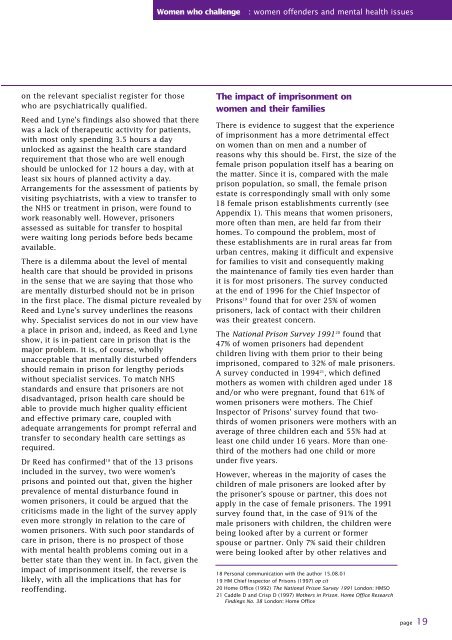Women who challenge - Nacro
Women who challenge - Nacro
Women who challenge - Nacro
- No tags were found...
Create successful ePaper yourself
Turn your PDF publications into a flip-book with our unique Google optimized e-Paper software.
<strong>Women</strong> <strong>who</strong> <strong>challenge</strong>: women offenders and mental health issueson the relevant specialist register for those<strong>who</strong> are psychiatrically qualified.Reed and Lyne’s findings also showed that therewas a lack of therapeutic activity for patients,with most only spending 3.5 hours a dayunlocked as against the health care standardrequirement that those <strong>who</strong> are well enoughshould be unlocked for 12 hours a day, with atleast six hours of planned activity a day.Arrangements for the assessment of patients byvisiting psychiatrists, with a view to transfer tothe NHS or treatment in prison, were found towork reasonably well. However, prisonersassessed as suitable for transfer to hospitalwere waiting long periods before beds becameavailable.There is a dilemma about the level of mentalhealth care that should be provided in prisonsin the sense that we are saying that those <strong>who</strong>are mentally disturbed should not be in prisonin the first place. The dismal picture revealed byReed and Lyne’s survey underlines the reasonswhy. Specialist services do not in our view havea place in prison and, indeed, as Reed and Lyneshow, it is in-patient care in prison that is themajor problem. It is, of course, <strong>who</strong>llyunacceptable that mentally disturbed offendersshould remain in prison for lengthy periodswithout specialist services. To match NHSstandards and ensure that prisoners are notdisadvantaged, prison health care should beable to provide much higher quality efficientand effective primary care, coupled withadequate arrangements for prompt referral andtransfer to secondary health care settings asrequired.Dr Reed has confirmed 18 that of the 13 prisonsincluded in the survey, two were women’sprisons and pointed out that, given the higherprevalence of mental disturbance found inwomen prisoners, it could be argued that thecriticisms made in the light of the survey applyeven more strongly in relation to the care ofwomen prisoners. With such poor standards ofcare in prison, there is no prospect of thosewith mental health problems coming out in abetter state than they went in. In fact, given theimpact of imprisonment itself, the reverse islikely, with all the implications that has forreoffending.The impact of imprisonment onwomen and their familiesThere is evidence to suggest that the experienceof imprisonment has a more detrimental effecton women than on men and a number ofreasons why this should be. First, the size of thefemale prison population itself has a bearing onthe matter. Since it is, compared with the maleprison population, so small, the female prisonestate is correspondingly small with only some18 female prison establishments currently (seeAppendix 1). This means that women prisoners,more often than men, are held far from theirhomes. To compound the problem, most ofthese establishments are in rural areas far fromurban centres, making it difficult and expensivefor families to visit and consequently makingthe maintenance of family ties even harder thanit is for most prisoners. The survey conductedat the end of 1996 for the Chief Inspector ofPrisons 19 found that for over 25% of womenprisoners, lack of contact with their childrenwas their greatest concern.The National Prison Survey 1991 20 found that47% of women prisoners had dependentchildren living with them prior to their beingimprisoned, compared to 32% of male prisoners.A survey conducted in 1994 21 , which definedmothers as women with children aged under 18and/or <strong>who</strong> were pregnant, found that 61% ofwomen prisoners were mothers. The ChiefInspector of Prisons’ survey found that twothirdsof women prisoners were mothers with anaverage of three children each and 55% had atleast one child under 16 years. More than onethirdof the mothers had one child or moreunder five years.However, whereas in the majority of cases thechildren of male prisoners are looked after bythe prisoner’s spouse or partner, this does notapply in the case of female prisoners. The 1991survey found that, in the case of 91% of themale prisoners with children, the children werebeing looked after by a current or formerspouse or partner. Only 7% said their childrenwere being looked after by other relatives and18 Personal communication with the author 15.08.0119 HM Chief Inspector of Prisons (1997) op cit20 Home Office (1992) The National Prison Survey 1991 London: HMSO21 Caddle D and Crisp D (1997) Mothers in Prison. Home Office ResearchFindings No. 38 London: Home Officepage 19
















